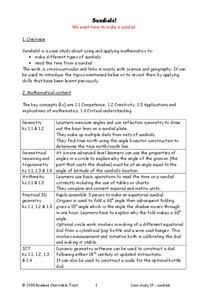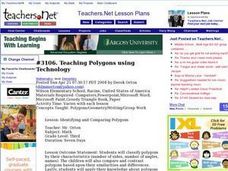Curated OER
Chemical Compounds
In this chemical compounds worksheet, students write the name of compounds from their chemical formula, balance equations, write electronic configurations for elements, and draw Lewis dot structures. This worksheet has 8 fill in the...
Curated OER
Math: Tangents
Students discover how to recognize tangents and how to use their properties. They investigate and use the properties of angles, arcs, chords, tangents, and secants. Students use two tangents and the properties of similar triangles to...
Curated OER
Math: Arcs and Chords
Students draw diagrams demonstrating how it is possible to two central angles to be congruent and their minor arcs are not congruent. In groups, they illustrate theorems with their constructed circles, create diameters of circles that...
Curated OER
Geometry: Lesson 2
Eighth graders engage in a lesson plan that is concerned with examining two dimensional figures with different properties that include circles, triangles, queadrilaterals, etc... They identify the types of figures that is identified as...
Curated OER
ndirect Measurement Technique: Using Trigonometric Ratios
Ninth graders find the height of an object that would be difficult or impossible to measure directly. They construct and use a Clinometer to measure the angle of elevation (or depression). Students create a sketch of the measurement...
Curated OER
Pattern Using Unit Cells
Students explore the pattern of the unit cell. In this science lesson, students color the unit cells on a worksheet and create a pattern using unit cells.
Curated OER
Building Bridges
Students identify the different types of bridges. Using the internet, they research information on how they are built by completing a scavenger hunt. Locating a specific area, they determine which type of bridge would be appropriate and...
Bowland
Sundials!
Time to learn about sundials. Scholars see how to build sundials after learning about Earth's rotation and its relation to time. The unit describes several different types of possible sundials, so choose the one that fits your needs — or...
Curated OER
Can You Name That Shape?
Learners use materials to build, investigate, and draw two-dimensional shapes (polygons). They combine the shapes they have built and draw from the pile to begin a round-robin activity to name and determine the attributes of a selection...
Curated OER
Powerful Polygons
Students scan the classroom to find different common shapes. They listen as the teacher defines polygon and regular polygon. The teacher demonstrates regular polygons via the Internet and the "Math is Fun" web site. Students go outside...
Curated OER
Teaching Polygons using Technology
Third graders utilize different types of computer programs, such as Microsoft paint and Microsoft Word to study and create different types of polygons. They use PowerPoint to create a story about a shape and others that it meets during a...
Curated OER
Rep Tiles
Third graders use pattern blocks of one shape at a time to try to create a similar shape. They compare the perimeter of the new figure with the perimeter of the original shape and look for a pattern. Students use the pattern to predict...
Curated OER
Math: Equal Area Triangles
Students examine a math worksheet and determine how to divide a single triangle into four of equal area. Using geometric principles, they sketch two additional ways to divide into into four equal triangles. To conclude, students...
Curated OER
Copycats
Third graders describe the features of 2 and 3 dimensional objects and use the language of geometry. They design and make a pattern which involves translation, reflection or rotation.
















